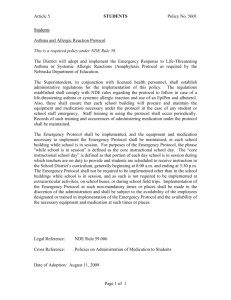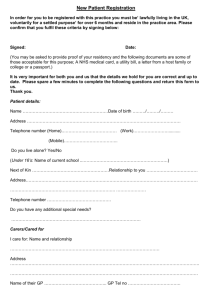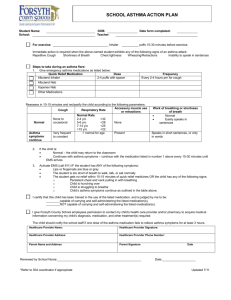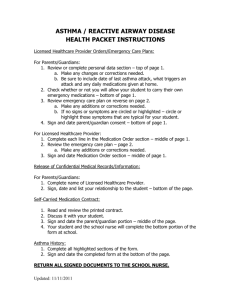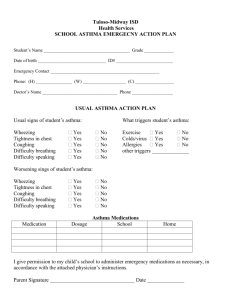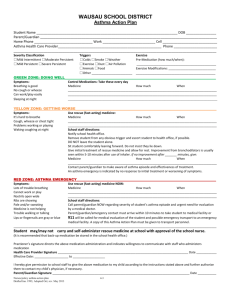Expectations for Asthma - Improving Chronic Illness Care
advertisement
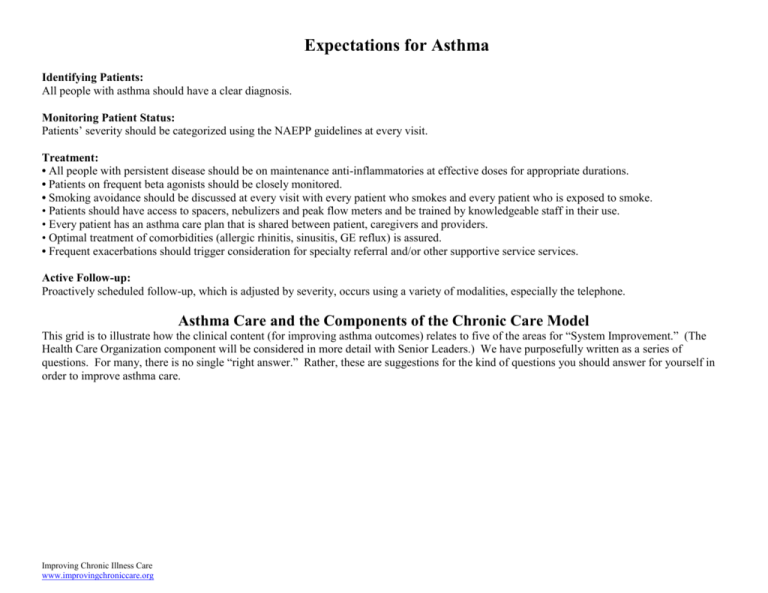
Expectations for Asthma Identifying Patients: All people with asthma should have a clear diagnosis. Monitoring Patient Status: Patients’ severity should be categorized using the NAEPP guidelines at every visit. Treatment: • All people with persistent disease should be on maintenance anti-inflammatories at effective doses for appropriate durations. • Patients on frequent beta agonists should be closely monitored. • Smoking avoidance should be discussed at every visit with every patient who smokes and every patient who is exposed to smoke. • Patients should have access to spacers, nebulizers and peak flow meters and be trained by knowledgeable staff in their use. • Every patient has an asthma care plan that is shared between patient, caregivers and providers. • Optimal treatment of comorbidities (allergic rhinitis, sinusitis, GE reflux) is assured. • Frequent exacerbations should trigger consideration for specialty referral and/or other supportive service services. Active Follow-up: Proactively scheduled follow-up, which is adjusted by severity, occurs using a variety of modalities, especially the telephone. Asthma Care and the Components of the Chronic Care Model This grid is to illustrate how the clinical content (for improving asthma outcomes) relates to five of the areas for “System Improvement.” (The Health Care Organization component will be considered in more detail with Senior Leaders.) We have purposefully written as a series of questions. For many, there is no single “right answer.” Rather, these are suggestions for the kind of questions you should answer for yourself in order to improve asthma care. Improving Chronic Illness Care www.improvingchroniccare.org Clinical Information Systems How can you identify your All people with asthma should have asthma population? a clear diagnosis. Delivery System Design Who is responsible for recording the diagnosis and informing the patient? Decision Support Self-management Support Community Resources and Policies Do you have an evidencebased guideline for diagnosis? Do patients receive a selfmanagement message at the time of diagnosis and an opportunity to ask questions? How are linkages made with schools, community centers, and employers to help identify patients with asthma? How do primary care doctors interact with specialists when diagnosis is complicated? How is the guideline disseminated to providers? Patients’ severity should be categorized using the NAEPP guidelines at every visit. Does the system prompt the Who completes assessments? assessment at every face-toface encounter? Who calls in the patients who are in need of assessment? How do you track results? All people with persistent disease should be on maintenance antiinflammatories at effective doses for appropriate durations. How can you identify subgroups of the asthma population? How do you document medication dosages, durations and results? How is the guideline “embedded” into your system? How is the NAEPP guideline for assessment disseminated to providers? How is the guideline “embedded” into your system? Who reviews the medication routine? Do you have an evidencebased guideline for medication prescribing Who calls the patients in when which describes effective medication routines are not doses and appropriate adequate? medications? What options are there for 1on-1, groups, phone-based counseling? Who gives on-going self management support for patients who have difficulty managing medication routines? How do patients participate in the assessment process? Do you have documentation of medication use in the asthma care plan? What links do you have set up to sources of medication for low-income patients? How is the guideline disseminated to providers? What “menus” of selfmanagement support are available to patients to assist them in managing medications? What resources are there in the community to assist families and patients with high severity or social risk? How is the guideline “embedded” into your system? What incentives do you have to encourage patients in appropriate medication use? What methods are available to assist patients with high severity or social risk? 2 (For children) Is the medication plan shared with school? (For adults) Is there worksite information that is being shared appropriately? Patients on frequent beta agonists should be closely monitored Smoking avoidance should be discussed at every visit with every patient who smokes and every patient who is exposed to smoke. How can you identify the Who reviews the medication subgroup of your asthma routine? population who is using beta agonists frequently? Who calls in the patients when medication routines are not How do you document and adequate? medication dosages, durations and results? How can you identify patients who smoke or who are exposed to smoke? How do you document and track those who have had a smoking intervention? Can your information system capture changes in smoking exposure? Does your information Patients should system capture current have access to spacers, nebulizers devices used by patients? and peak flow meters and be trained by knowledgeable staff in their use. Who reviews the smoking status? Who discusses smoking with patients? Who tracks which patients have been treated? Who is doing follow-up? What options are there for smoking cessation? Who is responsible for assessing technical skills and providing training in these skills? How are staff trained to use equipment effectively? Do you have an evidencebased guideline for betaagonist use? Do you have documentation of collaborative care plan for medication use? How is the guideline disseminated to providers? What self-management support is available to patients who are experiencing changes in their asthma control? How is the guideline “embedded” into your system? Do you have an evidencebased guideline for smoking cessation or decreasing smoking exposure? How is the guideline disseminated to providers? How is the guideline “embedded” into your system? Do guidelines address the use of spacers, nebulizers and peak flow meters? Are there criteria for staff training in equipment use? What kinds of groups, 1:1 or educational offerings are available to patients and caregivers? What kind of additional supports are available to patients in high risk situations? 3 What incentives do you have to encourage patients in appropriate medication use? Do you have documentation of collaborative goal setting for smoking avoidance? What links do you have set up to community smoking cessation programs? What “menus” of selfmanagement support are available to patients? Are there public stop smoking campaigns that you can support? What incentives do you have to encourage patients to quit smoking or decrease their exposure? Does the plan include patient What resources are and caregiver training in available in the community equipment use? to provide necessary equipment in a timely manner? Optimal treatment of comorbidities (allergic rhinitis, sinusitis, GE reflux) is assured. Frequent exacerbations should trigger consideration for specialty referral and/or other supports. Proactively scheduled followup, which is adjusted by severity, occurs using a variety of modalities, especially the telephone Every patient has an asthma care plan that is shared between patient, caregivers and providers. Does the information system Who is responsible for capture information on diagnosis and treatment of comorbidities? comorbidities? How do primary care providers and specialists interact for patients with comorbidities? Does the self-management What links can be made to support system encompass all local organizations who of the comorbidities? provide resources for comorbid conditions? Does the guideline address comorbidities? Does the information system Who is responsible for making Are criteria established for Does the self-management capture patients with referrals to appropriate referral to specialists and training include information frequent exacerbations? services? other services? on when other care providers might be helpful? What communication/referral How are these criteria mechanisms are in place to conveyed to the provider identify the correct providers when exacerbations are and smooth the referral noted? process? Does the information system Who is responsible for Are triggers for follow-up How are patients made aware produce information proactive follow-up? and content of follow-up of the follow-up contact they adjusted for severity contacts clearly described should expect? reminding providers when How is follow-up done? in the guidelines? patients require follow-up How are different modalities contact? used for different situations? How can you identify your asthma population? Is the care plan captured by the information system? Who is responsible for Are diagnostic criteria initiating the asthma plan and clearly described in the revising/renewing it yearly (at guideline? least)? How is the asthma plan incorporated into the visit structure? How are patients involved in developing the care plan? Does the care plan template include short and long-term How do any additional self-management goals in providers gain access to the addition to medication shared asthma care plan? regimen? How are patients instructed in how they should use the care plan? 4 How are existing networks of specialists and supportive services connected to the primary care providers? How is the care plan shared with daycare or school?
